Lipscomb, WN, An investigation of the reaction involving the preparation of hydrogen from sodium formate and sodium hydroxide, High school science research project, manuscript, 1937. Unpublished, except of course on the Internet.
This idea was original to Bill in high school, but not original to science, as BIll later, in college, found the reaction in a textbook.
In a cover note Bill adds that sodium formate was prepared for this research by the oxidation of an alkaline solution of formaldehyde with hydrogen peroxide as follows ...
H2O2 --> H2O + O
HCHO + O --> HCOOH
HCOOH + NaOH --> HCOONa + H2O
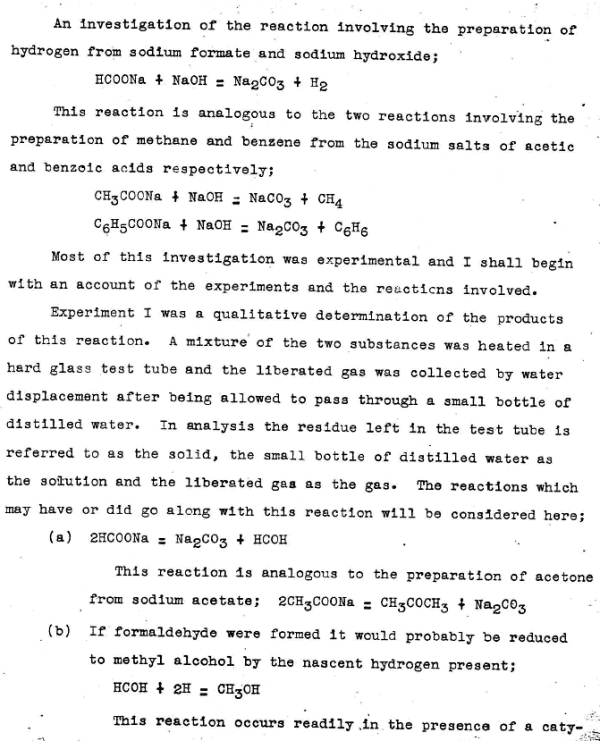
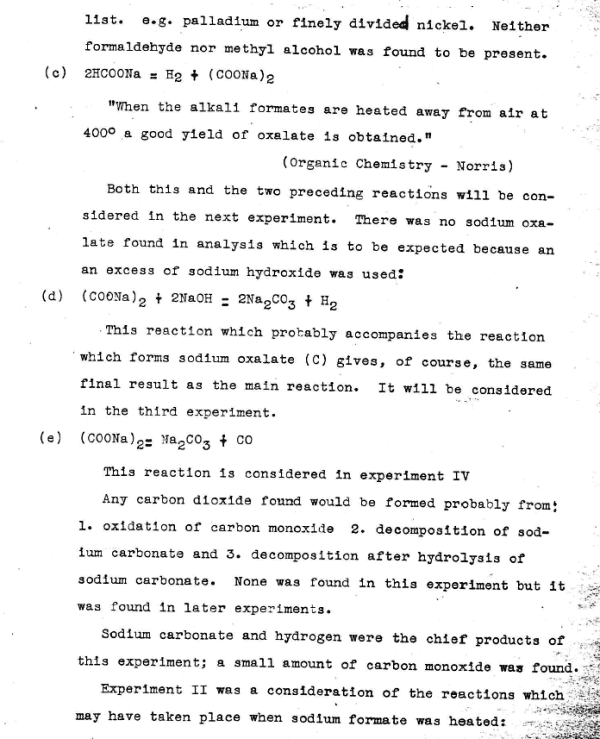
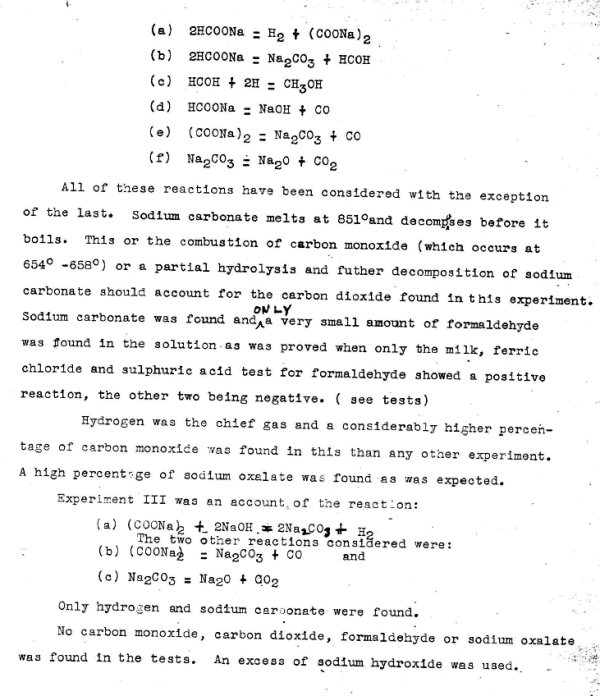
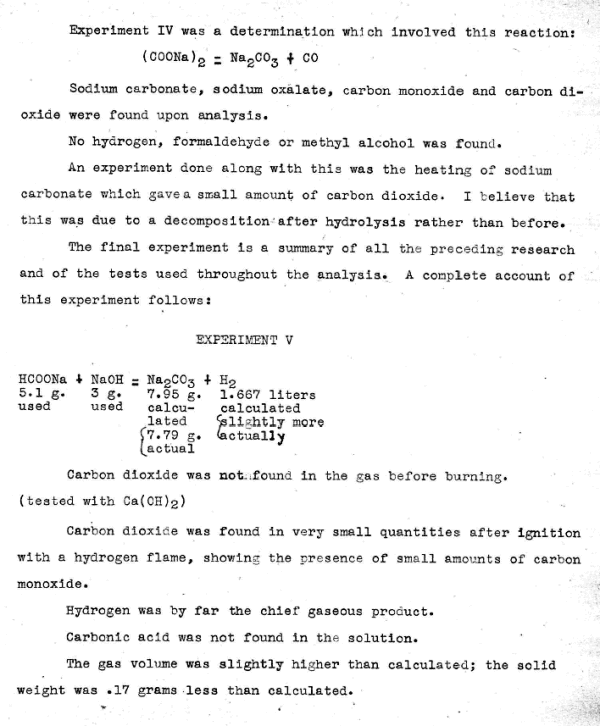
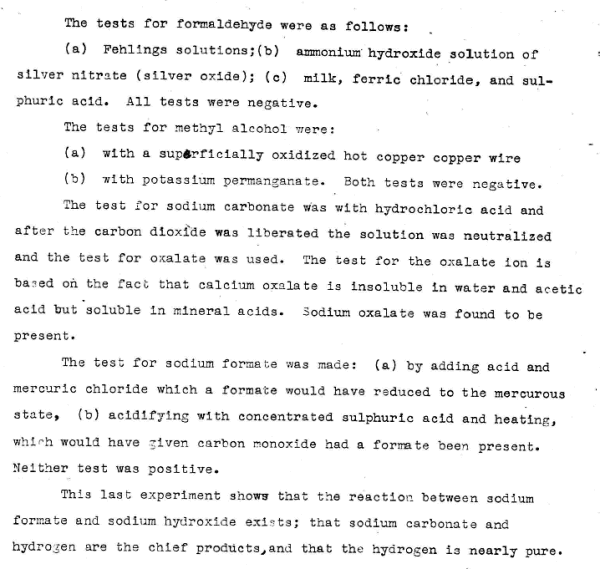
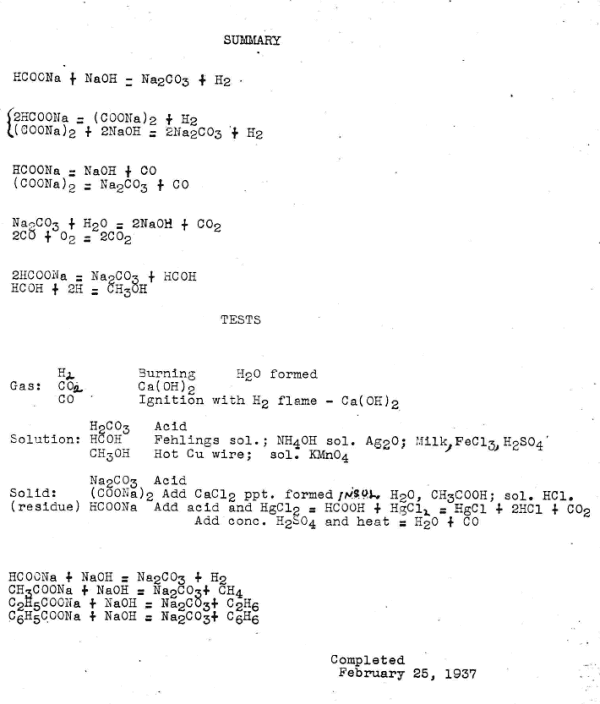
Image converted to text
An investigation of the reaction involving the preparation of hydrogen from sodium formate and sodium hydroxide;
This reaction is analogous to the two reactions involving the preparation of methane and benzene from the sodium salts of acetic and benzoic acids respectively;
Most of this investigation was experimental and I shall begin with an account of the experiments and the reactions involved.
Experiment I was a qualitative determination of the products of this reaction. A mixture of the two substances was heated in a hard glass test tube and the liberated gas was collected by water displacement after being allowed to pass through a small bottle of distilled water. In analysis the residue left in the test tube is referred to as the solid, the small bottle of distilled water as the solution and the liberated gas as the gas. The reactions which may have or did go along wlth this reaction will be considered here;
Experiment II was a consideration of the reactions which may have taken place when sodium formate was heated:
All of these reactions have been considered with the exception of the last. Sodium carbonate melts at 851° and decomposes before it boils. This or the combustion of carbon monoxide (which occurs at 654° - 658°) or a partial hydrolysis and futher decomposition of sodium carbonate should account for the carbon dioxide found in this experiment. Sodium carbonate was found and only a very small amount of formaldehyde was found in the solution as was proved when only the milk, ferric chloride and sulphuric acid test for formaldehyde showed a positive reaction, the other two being negative. ( see tests )
Hydrogen was the chief gas and a considerably higher percentage of carbon monoxide was found in this than any other experiment. A high percentage of sodium oxalate was found as was expected.
Experiment III was an account of the reaction:
Only hydrogen and sodium carbonate were found.
No carbon monoxide, carbon dioxide, formaldehyde or sodium oxalate was found in the tests. An excess of sodium hydroxide was used.
Experiment IV was a determination which involved this reaction:
Sodium carbonate, sodium oxalate, carbon monoxide and carbon dioxide were found upon analysis.
No hydrogen, formaldehyde or methyl alcohol was found.
An experiment done along with this was the heating of sodium carbonate which gave a small amount of carbon dioxide. I believe that this was due to a decomposition after hydrolysis rather than before.
The final experiment is a summary of all the preceding research and of the tests used throughout the analysis. A complete account of this experiment follows:
HCOONa + NaOH = Na2CO3 + H2
HCOONa: 5.1 g. used
NaOH: 3 g. used
Na2CO3: 7.95 g. calculated (7.79 g. actual)
H2: 1.667 liters calculated (slightly more actual)
Carbon dioxide was not found in the gas before burning. (tested with Ca(CH)2)
Carbon dioxide was found in very small quantities after ignition with a hydrogen flame, showing the presence of small amounts of carbon monoxide.
Hydrogen was by far the chief gaseous product.
Carbonic acid was not found in the solution.
The gas volume was slightly higher than calculated; the solid weight was .17 grams less than calculated.
The tests for formaldehyde were as follows:
(a) Fehlings solutions; (b) ammonium hydroxide so1ution of silver nitrate (silver oxide); (c) milk, ferric chloride, and sulphuric acid. All tests were negative.
The tests for methyl alcohol were:
The test for sodium carbonate was with hydrochloric acid and after the carbon dioxide was liberated the solution was neutralized and the test for oxalate was used. The test for the oxalate ion is based on the fact that calcium oxalate is insoluble in water and acetic acid but soluble in mineral acids- Sodium oxalate was found to be present.
The test for sodium formate was made: (a) by adding acid and mercuric chloride which a formate would have reduced to the mercurous state, (b) solidifying with concentrated sulphuric acid and heating, which would have given carbon monoxide had a forrate been present. Neither test was positive.
This last experiment shown that the reaction between sodium formate and sodium hydroxide exists; that sodium carbonate and hydrogen are the chief products,,and that the hydrogen is nearly pure.
HCOONa + NaOH = Na2CO3 + H2
( 2HCOONa = (COONa)2 + H2
(COONa)2 + 2NaOH = 2Na2CO3 + H2 )
HCOONa = NaOH + CO
(COONa)2 = Na2CO3 + CO.
Na2CO3 + H20 : 2NaOH + CO2
2CO + O2 = 2CO2
2HCOONa = Na2CO3 + HCOH
HCOH + 2H = CH3OH
COONa + NaOH = Na2CO3 + H2
CH3COONa + NaOH = Na2CO3 + CH4
C2H5COONa + NaOH = Na2CO3 + C2H6
C6H5COONa + NaOH = Na2CO3 + C6H6
Completed
February 25, 1937
Reprinted here with permission from William Lipscomb. Unpublished, except on the Internet.
HCOONa + NaOH = Na2CO3 + H2
This reaction is analogous to the two reactions involving the preparation of methane and benzene from the sodium salts of acetic and benzoic acids respectively;
CH3COONa + NaOH = NaCO3 + CH4
C6H5COONa. + NaOH= Na2CO3 + C6H6
C6H5COONa. + NaOH= Na2CO3 + C6H6
Most of this investigation was experimental and I shall begin with an account of the experiments and the reactions involved.
Experiment I was a qualitative determination of the products of this reaction. A mixture of the two substances was heated in a hard glass test tube and the liberated gas was collected by water displacement after being allowed to pass through a small bottle of distilled water. In analysis the residue left in the test tube is referred to as the solid, the small bottle of distilled water as the solution and the liberated gas as the gas. The reactions which may have or did go along wlth this reaction will be considered here;
(a} 2HCOONa = Na2CO3 + HCOH
This reaction is analogous to the preparation of acetone from sodium acetate; 2CH3COONa = CH3COCH3 + Na2CO3
(b) If formaldehyde were formed it would probably he reduced to methyl alcohol by the nascent hydrogen present;
HCOH + 2H = CH3OH
This reaction occurs readily in the presence of a catylist. e.g. palladium or finely divided nickel. Neither formaldehyde nor methyl alcohol was found to be present.
(c) 2HCOONa = H2 + (COONa)2
"When the alkali formates are heated away from air at 400° a good yield of oxalate is obtalned.”
(Organic Chemistry – Norris)
Both this and the two preceding reactions will be considered in the next experiment. There was no sodium oxalate found in analysis which is to be expected because an an excess of sodium hydroxide was used:
(d) (COONa)2 + 2NaOH = 2Na2CO3 + H2
This reaction which probably accompanies the reaction which forms sodium oxalate (C) gives, of course, the same flnal result as the main reaction. It will be considered in the third experiment.
(e) (COONa)2 = Na2CO3 + CO
This reaction is considered in experiment IV
Any carbon dioxide found would be formed probably from: 1. oxidation of carbon monoxide 2. decomposition of sodium carbonate and 3. decomposition after hydrolysis of sodium carbonate. None was found in this experiment but it was found in later experiments.
Sodium carbonate and hydrogen were the chief products of this experiment; a small amount of carbon monoxide was found.This reaction is analogous to the preparation of acetone from sodium acetate; 2CH3COONa = CH3COCH3 + Na2CO3
(b) If formaldehyde were formed it would probably he reduced to methyl alcohol by the nascent hydrogen present;
HCOH + 2H = CH3OH
This reaction occurs readily in the presence of a catylist. e.g. palladium or finely divided nickel. Neither formaldehyde nor methyl alcohol was found to be present.
(c) 2HCOONa = H2 + (COONa)2
"When the alkali formates are heated away from air at 400° a good yield of oxalate is obtalned.”
(Organic Chemistry – Norris)
Both this and the two preceding reactions will be considered in the next experiment. There was no sodium oxalate found in analysis which is to be expected because an an excess of sodium hydroxide was used:
(d) (COONa)2 + 2NaOH = 2Na2CO3 + H2
This reaction which probably accompanies the reaction which forms sodium oxalate (C) gives, of course, the same flnal result as the main reaction. It will be considered in the third experiment.
(e) (COONa)2 = Na2CO3 + CO
This reaction is considered in experiment IV
Any carbon dioxide found would be formed probably from: 1. oxidation of carbon monoxide 2. decomposition of sodium carbonate and 3. decomposition after hydrolysis of sodium carbonate. None was found in this experiment but it was found in later experiments.
(a) 2HCOONa = H2 + (COONa)2
(b) 2HCOONa = Na2CO3 + HCOH
(c) HCOH + 2H = CH3OH
(d) HCOONa = NaOH + CO
(e) (COONa)2 = Na2CO3 + CO
(f) Na2CO3 = Na2O + CO2
(b) 2HCOONa = Na2CO3 + HCOH
(c) HCOH + 2H = CH3OH
(d) HCOONa = NaOH + CO
(e) (COONa)2 = Na2CO3 + CO
(f) Na2CO3 = Na2O + CO2
All of these reactions have been considered with the exception of the last. Sodium carbonate melts at 851° and decomposes before it boils. This or the combustion of carbon monoxide (which occurs at 654° - 658°) or a partial hydrolysis and futher decomposition of sodium carbonate should account for the carbon dioxide found in this experiment. Sodium carbonate was found and only a very small amount of formaldehyde was found in the solution as was proved when only the milk, ferric chloride and sulphuric acid test for formaldehyde showed a positive reaction, the other two being negative. ( see tests )
Hydrogen was the chief gas and a considerably higher percentage of carbon monoxide was found in this than any other experiment. A high percentage of sodium oxalate was found as was expected.
Experiment III was an account of the reaction:
(a) (COONa)2 + 2NaOH = 2Na2CO3 + H2
The two other reactions considered were:
(b) (COONa)2 = Na2CO3 + CO and
(c) Na2CO3 = Na2O + CO2
The two other reactions considered were:
(b) (COONa)2 = Na2CO3 + CO and
(c) Na2CO3 = Na2O + CO2
Only hydrogen and sodium carbonate were found.
No carbon monoxide, carbon dioxide, formaldehyde or sodium oxalate was found in the tests. An excess of sodium hydroxide was used.
Experiment IV was a determination which involved this reaction:
(COONa)2 = Na2CO3 + CO
Sodium carbonate, sodium oxalate, carbon monoxide and carbon dioxide were found upon analysis.
No hydrogen, formaldehyde or methyl alcohol was found.
An experiment done along with this was the heating of sodium carbonate which gave a small amount of carbon dioxide. I believe that this was due to a decomposition after hydrolysis rather than before.
The final experiment is a summary of all the preceding research and of the tests used throughout the analysis. A complete account of this experiment follows:
EXPERIMENT V
HCOONa + NaOH = Na2CO3 + H2
HCOONa: 5.1 g. used
NaOH: 3 g. used
Na2CO3: 7.95 g. calculated (7.79 g. actual)
H2: 1.667 liters calculated (slightly more actual)
Carbon dioxide was not found in the gas before burning. (tested with Ca(CH)2)
Carbon dioxide was found in very small quantities after ignition with a hydrogen flame, showing the presence of small amounts of carbon monoxide.
Hydrogen was by far the chief gaseous product.
Carbonic acid was not found in the solution.
The gas volume was slightly higher than calculated; the solid weight was .17 grams less than calculated.
The tests for formaldehyde were as follows:
(a) Fehlings solutions; (b) ammonium hydroxide so1ution of silver nitrate (silver oxide); (c) milk, ferric chloride, and sulphuric acid. All tests were negative.
The tests for methyl alcohol were:
(a) with a superficially oxidized hot copper copper wire
(b) with potassium permanganate. Both tests were negative.
(b) with potassium permanganate. Both tests were negative.
The test for sodium carbonate was with hydrochloric acid and after the carbon dioxide was liberated the solution was neutralized and the test for oxalate was used. The test for the oxalate ion is based on the fact that calcium oxalate is insoluble in water and acetic acid but soluble in mineral acids- Sodium oxalate was found to be present.
The test for sodium formate was made: (a) by adding acid and mercuric chloride which a formate would have reduced to the mercurous state, (b) solidifying with concentrated sulphuric acid and heating, which would have given carbon monoxide had a forrate been present. Neither test was positive.
This last experiment shown that the reaction between sodium formate and sodium hydroxide exists; that sodium carbonate and hydrogen are the chief products,,and that the hydrogen is nearly pure.
SUMMARY
HCOONa + NaOH = Na2CO3 + H2
( 2HCOONa = (COONa)2 + H2
(COONa)2 + 2NaOH = 2Na2CO3 + H2 )
HCOONa = NaOH + CO
(COONa)2 = Na2CO3 + CO.
Na2CO3 + H20 : 2NaOH + CO2
2CO + O2 = 2CO2
2HCOONa = Na2CO3 + HCOH
HCOH + 2H = CH3OH
TESTS
| H2 | Burning H2O formed | |
| Gas: | CO2 | Ca(OH)2 |
| CO | Ignition with H2 flame – Ca(OH)2 |
| H2CO3 | Acid | |
| Solution: | HCOH |
Fehlings sol.; NH4OH sol Ag2O; Milk, FeCl3, H2SO4 |
| CH3OH | Hot Cu wire; sol. KMnO4 |
| Na2CO3 | Acid | |
| Solid: | (COONa)2 | Add CaCl2 ppt. formed insol. H2O, CH3COOH; sol. HCl |
| (residue) | HCOONa | Add acid and HgCl2 = HCOOH + HgCl2 = HgCl + 2HCl + CO2 Add conc. H2SO4 and heat = H2O + CO |
COONa + NaOH = Na2CO3 + H2
CH3COONa + NaOH = Na2CO3 + CH4
C2H5COONa + NaOH = Na2CO3 + C2H6
C6H5COONa + NaOH = Na2CO3 + C6H6
Completed
February 25, 1937
Reprinted here with permission from William Lipscomb. Unpublished, except on the Internet.
 Home page https://wlipscomb.tripod.com/
Home page https://wlipscomb.tripod.com/